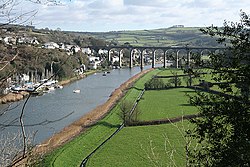River Tamar
The River Tamar is a river in South West England, that forms most of the border between Devon (to the east) and Cornwall (to the west). The Tamar's source is less than 6 km (4 miles) from the north Cornish coast, but it flows southward. At its mouth, the Tamar flows into the Hamoaze (a wide estuary) before entering Plymouth Sound. Tributaries of the river include the rivers Inny, Ottery, Kensey and Lynher (or St Germans River) on the Cornish side, and the Deer and Tavy on the Devon side.
King Athelstan of England made the east bank of the River Tamar the boundary between England and Cornwall in the year 936. There are no road bridges over the lower Tamar apart from the modern Tamar Bridge at Saltash which was built to replace the ferry. In 1859 the Royal Albert Bridge was built across the Tamar at Saltash to carry the main railway line into Cornwall. Both bridges connect Saltash with Plymouth.
The Tamar Valley Area of Outstanding Natural Beauty covers around 195 km² (75 square miles) around the lower Tamar (below Launceston) and its tributaries the Tavy and the Lynher. It was first proposed in 1963, but was not designated until 1995.[1]
River Tamar Media
The dam of the Upper Tamar Lake.
Loading dock at Morwellham; once an important industrial port, it featured an inclined plane which led up to the Tavistock Canal
High tide at Weir Head — excursion steamer Alexandra, 127 gross register tons, 126 feet in length, reversing at the entrance to the Tamar Manure Canal, in 1906.
The Tamar Valley Line railway crosses the Tamar on a viaduct, built in 1907, at Calstock.
The Royal Albert Bridge and the Tamar Bridge at Saltash.
References
- ↑ "Tamar Valley Area of Outstanding Natural Beauty". Archived from the original on 2009-05-15. Retrieved 2011-06-07.











